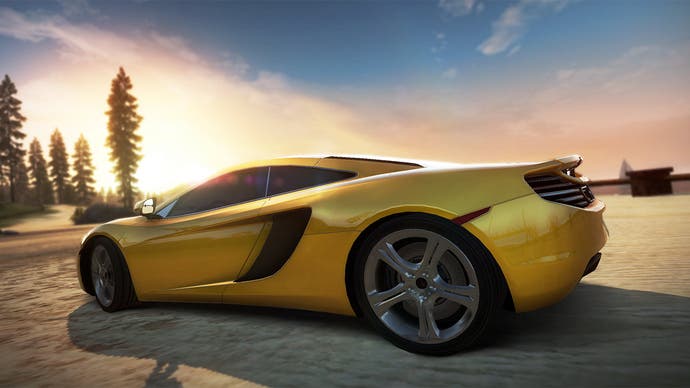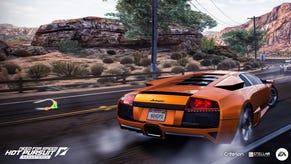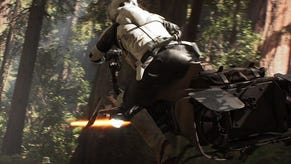Need for Speed: Hot Pursuit
Social network king.
While the traditional single-player event progression system is in place for those who want it, Autolog offers an alternative way to experience the game, by playing the best it has to offer based on the experiences of your friends, served up to you in the form of social networking along with dynamically generated challenges derived from the best performances of those on your friends list.
"This is a network of people playing Need for Speed; everything the player does, everything your friends are doing, is being sent to Autolog and we've got this really cool piece of tech called a comparison engine, which takes that data and does a huge amount of comparisons against everyone in your network and delivers personalised, dynamic recommendations," explains Webster. "You can go and compete in events your friends have played that you haven't unlocked. The concept behind this is to link everyone up. It's a clever piece of tech really. There's a whole bunch of different things that just one piece of gameplay could say."
Need for Speed: Hot Pursuit allows for simultaneous online play with up to eight players, and thanks to Autolog, joining an existing player's online game is a simple matter of just pressing a button and joining in. However, another of Autolog's strengths is that it recognises that more often than not different people play the same game at different times.
"I hate the phrase, but asynchronous gameplay is very important. Being able to play against my friends when they're not online is really important. We've done it before: six players in Burnout 3, eight players in Paradise. We can do that directly-connected stuff, we know that.
"There's this whole other side where we all lead busy lives, it's hard enough to arrange to a bunch of people to go down the pub together let alone get online together. Here I can play what my friends have been playing, I'm getting these personalised recommendations and then when I act upon them, the results of what I do are broadcast into my network of friends and it's generating things to do based on that."

Criterion also sees the asynchronous play as being instrumental in maintaining the game's longevity. As players progress through the game amassing newer and more powerful vehicles, online records on the older races will fall, promoting new challenges and competitive play. "Friends comparison is everywhere in the game. Everywhere," says Sullivan. "Even if I'm playing this race for the 50th time and I'm pissing all over the guys I'm racing with, I can still go back and continue playing against my friends. there's always a new goal."
"That's what we found coming out of Paradise, we had asynchronous racing comparisons but they were never really at the fore," adds Webster. "When people had tired of the stuff we'd authored for them, the huge amount of game there, it actually started to be far more active on the async play side. Beating a time, seeing it go up, seeing the changes, trying to beat it - that cycle amongst friends is really powerful."
The Criterion guys are dismissive of the way that recent games have utilised Twitter and Facebook updates, and pledge to use these networks in a less intrusive manner with Need for Speed: Hot Pursuit. They're used as tools to enhance your friends network, and the game will rarely intrude on the outside world, for one very good reason. "Using Facebook, you're talking to people who don't care. First of all we need to start with the people who do care," says Webster.
"Also we can use Facebook, we can look through your friends list and tell you, 'Hey look, Craig's got Need for Speed'. Maybe you didn't know that. He might not be in your first-party friends network but he's in your Facebook network so we can join people together like that."
Criterion is so confident in the Autolog network that it reckons its dynamic nature will prove to make it a far more compelling proposition than the old single-player progression system.
"Autolog ties everything together," says Sullivan. "That's the key part: the friends comparison. The reason why we've done that is for the first time I'm choosing an event based on what my friends have done even before I've played it myself. So I might be looking around at some event but it'll be locked, but I can see that Matt and three or four of my friends have been playing it a lot, so I'll go in and I'll do that. The main way of navigating through the different things you can do in the game is through Autolog, through that menu system."
Webster sums up the Autolog experience succinctly. "When you go into the recommendations area of Autolog, it's almost like looking at the specials in a restaurant," he explains. "You've got the a la carte stuff, you've got the specials and you're like, 'Oh I'll take that'. It's that simple little wisdom of crowds stuff - five friends are playing that, it makes you want to get involved too."

Watching Autolog in motion, its various feeds backed by the throbbing soundtrack make it feel like the heartbeat of the game. Friends, data and photos continuously stream into view, all offering new gameplay opportunities and challenges. But what of the game itself?
Just like the brand new engine that runs it, Need for Speed: Hot Pursuit feels fresh and focused. Unlike Criterion's previous racers, it's 30FPS rather than 60FPS (though powerful PCs can reach the latter frame-rate), but thanks to some superb engineering it feels crisp and significantly more responsive than other driving games running at the same frame-rate. Drifts just feel right, and the make-up of the road layouts has been designed to get the most out of that.
Criterion's design team has taken specific areas of the open world and deploys them in each of the events, choosing the right cars for the right parts of the world, and even selecting the most appropriate time of day for the gameplay being served up. Yes, Need for Speed: Hot Pursuit even includes dynamic time of day, effectively showcasing the impressive lighting system created especially for the game.
"The cool thing there is that you can be on the same road you were on in the middle of the day, at night, and it's going to feel and look very, very different. You get a lot of visual variety that way. It changes the nature of how it is to drive," Sullivan reveals, before going on to explain how time of day can have a crucial impact on gameplay.
"On the shorter events, the races, it'll choose the best time of day based on the cars and how we want it to feel. On some of the hot pursuits, the chases can go on for five, six, seven minutes. We choose the time to start, then let the time of day cycle. In Free Drive, it just cycles through. We have enough to control so we can say that this event's going to be about chasing this black car at night - it's harder, he can turn his lights off and try to hide from you."








